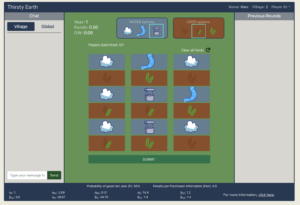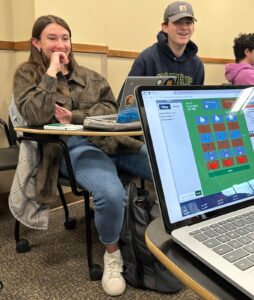
The Rising Need for Interdisciplinary Literacy
The sustainable management of water resources requires cooperative institutions whose development are rarely included in already overloaded engineering and earth sciences curricula. The resilience of such institutions in the context of climatic and demographic change is also poorly understood. Enter “Thirsty Earth,” an online open-access multiplayer simulation game designed to bridge this gap through experiential learning.
Experiential learning combined with theoretical background, for instance through interactive teaching modules embedded within standard water management and hydrology classes, has been shown to increase students’ interest and understanding of complex topics. The game – and associated educational material — is freely available here and we welcome any feedback and suggestions.
Experiencing Key Water Management Trade-offs
In Thirsty Earth, students play the role of farmers in rural communities making annual decisions on crop types and water sources, balancing the need to maximize agricultural profits against the limitations of shared water resources. The game combines theoretical knowledge with practical application, significantly enhancing students’ interest and understanding of these complex issues. It introduces players to three fundamental trade-offs that are at the heart of many of today’s water management challenges:
- Sustainability: Players choose between sustainable and unsustainable groundwater pumping, experiencing the economic trade-offs between long-term and short-term profits.
- Environmental Risk: The game illustrates the risk-taking versus risk-aversion dilemma through rainfed farming, where profits depend on unpredictable weather patterns.
- Common-Pool Management: Players navigate the choice between maximizing their own immediate profit or trusting their peers’ ability to act responsibly to maximize everybody’s ultimate profits, thus exploring the concepts of Nash equilibrium and First-best optimal strategies in resource usage.

Example of a player’s screen during round 4 of the game. Each field is denoted by a blue box (indicating irrigation source) on top of a brown box (indicating crop choice).
Designing Cooperative Institutions
After their initial gameplay, students are introduced to Ostrom’s design principles for long enduring institutions to manage common-pool resources. These principles are implemented within the game by allowing players to purchase and share reliable bits of information on the status and use of water resources, which can then be used to regulate behavior through collective action. Students engage into group-based discussion on which information bits to purchase and how to use them collaboratively to create self-regulating institutions. Discussions are structured around Crawford and Ostrom’s ADICO syntax defining what are the rules, what is their aim, who they apply to, when they apply, and what are the consequences of breaking them. These principles are enshrined in a community-level “constitution” and used to govern a second iteration of the game. By comparing outcomes to the initial gameplay, students experience for themselves the benefits of cooperative institutions.
Implementation
“Thirsty Earth” was successfully incorporated into the Water Governance unit of a Sustainability class at the University of Notre Dame in Spring 2023. The class included 29 students from a variety of disciplines (all engineering subfields, political science, business, physics, and environmental science) and class levels (1st to 4th year Bachelor study). Debriefing through online (forum posts) and in-class discussion provided overwhelmingly positive feedback on the game as an engaging means to raise interest and basic literacy in topics such as incentives, governance, and institutions, that are often excluded from engineering curricula. As such, Thirsty Earth highlights the potential of interactive learning tools in higher education. By simulating real-world scenarios and trade-offs, it prepares students not just for their academic pursuits, but for the larger challenges they will face in managing our planet’s precious resources.

University of Notre Dame undergraduate students playing Thirsty Earth in class, Spring 2023.
Extension for experimental research
The game’s potential extends beyond education, and we are currently developing a research version of the game. That version will be deployed massively online via the Mechanical Turk platform, where it will serve as a platform for experimental behavioral research, for instance to understand how water decisions, incentives and institutions might be affected by climate and socioeconomic change. We expect this novel experimental platform to be versatile and are open to new collaborations – please do not hesitate to reach out!
Acknowledgments
We are grateful to the Notre Dame Center for Research Computing for their superb technical support and acknowledge the US National Science Foundation (Graduate Research Fellowship Program and Grant EAR 2142967) for funding.




